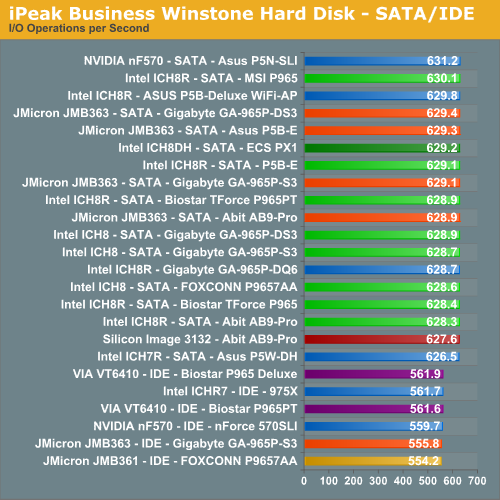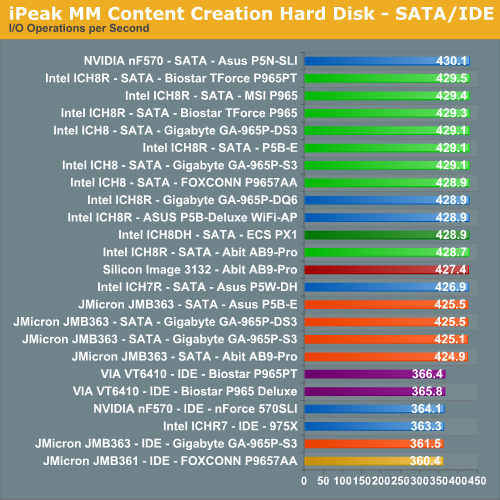Intel P965: Foxconn P9657AA- 8KS2H
by Gary Key on December 28, 2006 7:00 AM EST- Posted in
- Motherboards
Disk Controller Performance
The AnandTech iPeak test is designed to measure "pure" hard disk controller performance, and in this case we keep the hard drive as consistent as possible while varying the hard drive controller. The idea is to measure the performance of each hard drive controller with the same hard drive.
We played back our raw files that are recorded I/O operations when running a real world benchmark - the entire Winstone 2004 suite. Intel's iPeak utility was then used to play back the trace file of all I/O operations that took place during a single run of Business Winstone 2004 and MCC Winstone 2004. To try to isolate performance differences to the controllers that we are testing we are using the Western Digital 74GB Raptor with 16MB cache for both our standard disk controller and RAID performance tests for this article. The drive is formatted before each test run and a composite average of three tests on each controller interface is tabulated in order to ensure consistency in the benchmark.
iPeak gives a mean service time in milliseconds; in other words, the average time that each drive took to fulfill each I/O operation. In order to make the data more understandable, we report the scores as an average number of I/O operations per second so that higher scores translate into better performance. This number is somewhat meaningless as far as hard disk performance is concerned, as it is just the number of I/O operations completed in a second. However, the scores are useful for comparing "pure" performance of the storage controllers in this case.


The performance patterns hold steady across both Multimedia Content I/O and Business I/O, with the NVIDIA nForce 500 based SATA controllers providing a slight improvement in I/O operations over the Intel, JMicron, and Silicon Image SATA controllers. This has been a historical trend between the two manufacturers with the NVIDIA controllers generally having a higher throughput than the Intel chipsets.
However, our recent testing of the AMD 600 chipset with the SB600 Southbridge showed the strength of this chipset by finishing ahead of the other offerings. We also noticed that the latest drivers from Intel along with optimizations on the Intel DB975XBX2 showed that the Intel chipsets are now very competitive with the new NVIDIA 680i boards.
Of note in our SATA tests is the excellent performance generated by the JMicron controller logic that scored higher than the Intel ICH7R or ICH8 based SATA controllers in the Business Winstone test. However, in the read and write heavy Content Creation tests we see the Intel SATA controllers placing ahead of the JMicron offerings. After reviewing the test script results we noticed the write operations of the JMicron JMB363 chipset was about 3% slower than the Intel ICH chipsets while being around 2% faster in read operations. We tested the e-SATA capability of the JMB361 chipset on the Foxconn board and did not encounter any issues with attaching our test drives or their performance.
The VIA VT6410 controller offered the best performance in the IDE tests with the JMicron JMB363 finishing last. During initial testing with the JMicron chipset we noticed several boards having issues with the optical drives being stuck in PIO mode resulting in terrible performance. However, this issue was solved with BIOS updates from the motherboard suppliers. We also advise that you utilize the latest JMicron JMB361 driver on the Foxconn board to avoid IDE compatibility issues with older drives.
The AnandTech iPeak test is designed to measure "pure" hard disk controller performance, and in this case we keep the hard drive as consistent as possible while varying the hard drive controller. The idea is to measure the performance of each hard drive controller with the same hard drive.
We played back our raw files that are recorded I/O operations when running a real world benchmark - the entire Winstone 2004 suite. Intel's iPeak utility was then used to play back the trace file of all I/O operations that took place during a single run of Business Winstone 2004 and MCC Winstone 2004. To try to isolate performance differences to the controllers that we are testing we are using the Western Digital 74GB Raptor with 16MB cache for both our standard disk controller and RAID performance tests for this article. The drive is formatted before each test run and a composite average of three tests on each controller interface is tabulated in order to ensure consistency in the benchmark.
iPeak gives a mean service time in milliseconds; in other words, the average time that each drive took to fulfill each I/O operation. In order to make the data more understandable, we report the scores as an average number of I/O operations per second so that higher scores translate into better performance. This number is somewhat meaningless as far as hard disk performance is concerned, as it is just the number of I/O operations completed in a second. However, the scores are useful for comparing "pure" performance of the storage controllers in this case.


The performance patterns hold steady across both Multimedia Content I/O and Business I/O, with the NVIDIA nForce 500 based SATA controllers providing a slight improvement in I/O operations over the Intel, JMicron, and Silicon Image SATA controllers. This has been a historical trend between the two manufacturers with the NVIDIA controllers generally having a higher throughput than the Intel chipsets.
However, our recent testing of the AMD 600 chipset with the SB600 Southbridge showed the strength of this chipset by finishing ahead of the other offerings. We also noticed that the latest drivers from Intel along with optimizations on the Intel DB975XBX2 showed that the Intel chipsets are now very competitive with the new NVIDIA 680i boards.
Of note in our SATA tests is the excellent performance generated by the JMicron controller logic that scored higher than the Intel ICH7R or ICH8 based SATA controllers in the Business Winstone test. However, in the read and write heavy Content Creation tests we see the Intel SATA controllers placing ahead of the JMicron offerings. After reviewing the test script results we noticed the write operations of the JMicron JMB363 chipset was about 3% slower than the Intel ICH chipsets while being around 2% faster in read operations. We tested the e-SATA capability of the JMB361 chipset on the Foxconn board and did not encounter any issues with attaching our test drives or their performance.
The VIA VT6410 controller offered the best performance in the IDE tests with the JMicron JMB363 finishing last. During initial testing with the JMicron chipset we noticed several boards having issues with the optical drives being stuck in PIO mode resulting in terrible performance. However, this issue was solved with BIOS updates from the motherboard suppliers. We also advise that you utilize the latest JMicron JMB361 driver on the Foxconn board to avoid IDE compatibility issues with older drives.










9 Comments
View All Comments
atlr - Friday, April 6, 2007 - link
A P9657AA-8EKRS2H / P9657AA-8KS2H BIOS dated April 5, 2007 has been released.No description about what's different though.
http://www.foxconnchannel.com/EN-US/service/downlo...">http://www.foxconnchannel.com/EN-US/ser...9657AA-8...
Sh0ckwave - Sunday, December 31, 2006 - link
343fsb is crap. no one will buy this for overclocking.ssiu - Thursday, January 11, 2007 - link
Seems like this could be a good option for ultra-budget E4300 overclocking. 9x343FSB = 3.087Ghz is pretty good. Save $30 on motherboard, use stock heatsink and save $$, save some more with cheaper DDR2-667 memory, etc.yyrkoon - Thursday, December 28, 2006 - link
Wouldnt it be nice is manufactures started making mother boards with loads of features, but without all the unnecessary stuff like SLI, dual GbE etc ?Personally, Id like to see a board like the Asus Striker, or ABIT IN9 32x-MAX, that didn't have SLI, and dual GbE. SO in other words, Something along the lines of these types of boards, but with the latest chip sets, eSATA (maybe), loads of disk ports, etc.
BladeVenom - Thursday, December 28, 2006 - link
I'd like to see at least one company make a motherboard with no legacy ports, and no built in audio. Who needs it, and why pay for it if you don't.Beachspree - Friday, December 29, 2006 - link
I'll keep repeating this with each review in the hope of getting a reply. ;-)I was wondering why the Firewire performance is so poor in these reviews:
Firewire 400 gets a best throughput of 230.6Mb/s
It is known that Macs have poor USB 2 performance but look at the Firewire results by Barefeats:
http://www.barefeats.com/usb2.html">http://www.barefeats.com/usb2.html
http://www.barefeats.com/hard70.html">http://www.barefeats.com/hard70.html
Without the perfect conditions of a RAM disk, and without cacheing turned off, they get real world performance of up to:
Firewire 400: 304 Mb/s (31% faster than PC)
Firewire 800: 464 Mb/s (41% faster than PC)
For comparison, Macs are getting lousy USB 2 performance. Intel Macs have improved it but that takes it from around 136Mb/s to 168Mb/s. That's 75% slower.
Given the importance of Firewire in multimedia applications, for which it can be critical, does this poor performance not warrant a mention?
To be clearer:
Can we please have some real world figures for USB 2.0, eSATA and Firewire 400/800 transfers under default settings and off an internal 7200 HDD you standardize on. That's what most people actually do when the backup, so that's what we need to see in order to make informed choices. I suspect these data rates you keep publishing are ones we will actually never see.
I suggest, also, that poor Firewire performance in Windows is more important than poor USB on Macs. They always have Firewire built in and tend to it on peripherals, while Windows users often make do with USB until they get into music or video editing when they then find the need for Firewire and hit this poor performance just when they start needing mission critical performance. I'm talking about dropped frames and music latency.
Why is that ignored in all your motherboard reviews?
Thanks.
SonicIce - Thursday, December 28, 2006 - link
What speakers or headphones do you use to test audio?Orbs - Thursday, December 28, 2006 - link
I have this board in a machine I'm using as a personal server. I paired it with G.Skill F2-6400CL5D-2GBNQ (2 x 1GB of DDR2 800) and it would crash randomly with that ram. After talking to G.Skill, it seems like there is an issue with that ram and all reference-based P965 boards including this board.Memtest86 also failed test #5 consistently with this ram on this board.
G.Skill is sending me replacement ram (their F2-6400PHU2-2GBNR) which should be here next week. Hopefully it's more stable.
Orbs - Thursday, December 28, 2006 - link
Just to be clear, I'm not saying this board or Foxconn is at fault for the compatibility issues, I'm just noting my experience so others don't run into the same problem.